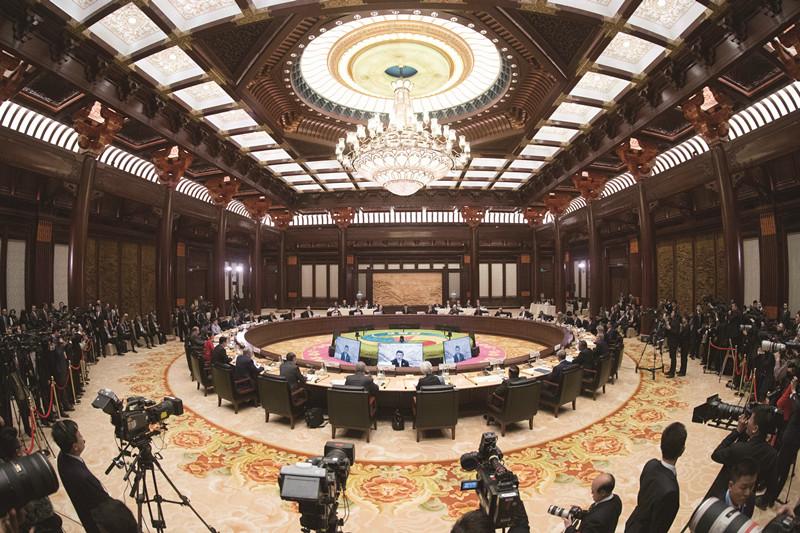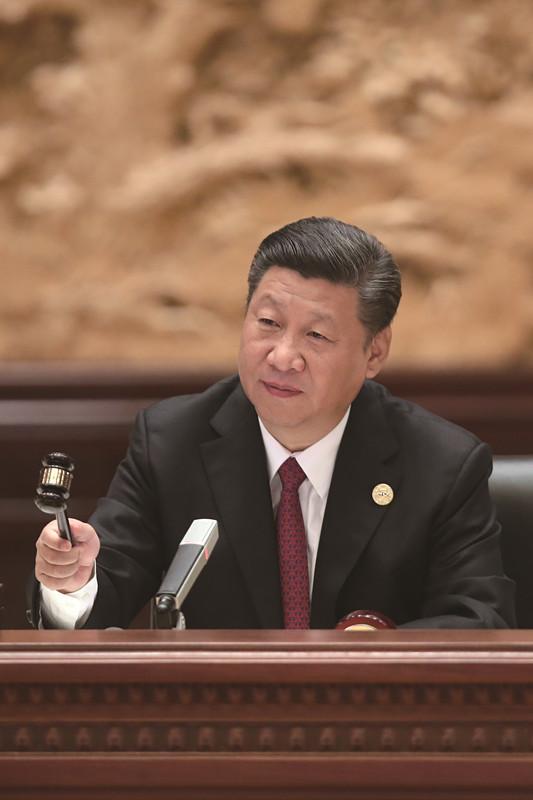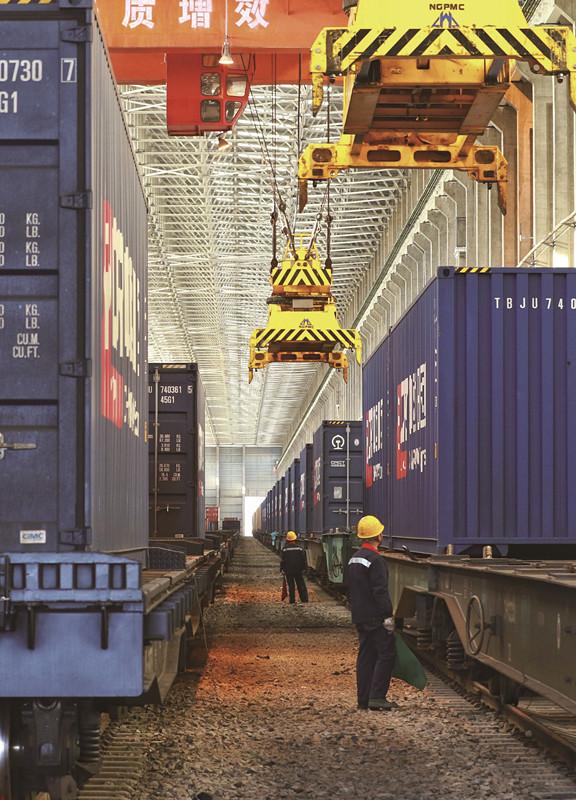
 Old Version
Old Version

Chinese President Xi Jinping chairs the Leaders’ Roundtable Summit at the Belt and Road Forum for International Cooperation at Yanqi Lake International Convention Center, Beijing, May 15, 2017
Belt and Road
First launched in 2013, the Belt and Road initiative is a signature foreign policy initiative of Chinese President Xi Jinping. The initiative comprises two components, the Silk Road Economic Belt (the Belt) and the 21st-century Maritime Silk Road (the Road). Together, the project aims to create a web of infrastructure, including roads, railways, telecommunications, pipelines and seaports, and to enhance economic interconnectivity and growth in the regions along the Belt and Road routes.
To facilitate the initiative, China established the US$40 billion Silk Road Fund, which, alongside the multilateral Asian Infrastructure Investment Bank (AIIB), serve the two as financial vehicles for infrastructure projects under the framework of the Belt and Road initiative.
During the summit, China signed agreements and deals with a total of 68 countries and international organizations under the Belt and Road framework, including Greece, Poland, Russia, Turkey, Thailand, Nepal, Sri Lanka, Egypt and Argentina.
Besides the bilateral and multilateral deals reached during the summit, China made new pledges to further boost funding for the project, including an additional 100 billion yuan (US$14.5bn) into the Silk Road Fund. In the meantime, the China Development Bank and China’s Export-Import Bank will set up new lending schemes of 250 billion yuan (US$36.2bn) and 130 billion yuan (US$18.8bn) respectively, for relevant Belt and Road projects. China also pledged to provide 60 billion yuan (US$8.7bn) in development aid in the next three years to countries along the Belt and Road region.
For many Chinese experts, by gathering leaders around the world and having a multilateral summit focusing on the Belt and Road initiative, the biggest achievement of the forum is to move the project from being just a China-led initiative to a multilateral one.
Since launching the initiative, China has been emphasizing the co-operative and “win-win” nature of the Belt and Road, though there have been concerns, especially from the Western countries, regarding China’s geopolitical ambitions.
In recent years, instead of projecting the initiative to other countries, China has attempted to link the Belt and Road with development projects launched by relevant countries themselves to minimize the strategic concerns over China’s objectives.
In his speech addressed to the opening ceremony of the Belt and Road Forum, Xi reiterated that the initiative is built upon principles of “peace and cooperation,” “openness and inclusiveness,” “mutual learning” and “mutual benefit.” Xi said that China has managed to align the Belt and Road with the Russia-led Eurasian Economic Union, Poland’s Amber Road and Turkey’s Middle Road, as well as with projects launched by ASEAN, Kazakhstan, Mongolia, Vietnam and the UK.
China has also linked the Belt and Road initiative to the United Nations’ 2030 Agenda for Sustainable Development Cooperation. Among the various cooperation documents released by the Belt and Road Forum is the Promoting Unimpeded Trade Cooperation along the Belt and Road signed between China and some 60 countries and international organizations.
According to Zhang Yunling, Director of the Institute of Asia Pacific Studies of the Chinese Academy of Social Sciences, efforts like these have gradually transformed the Belt and Road from a Chinese initiative to a multilateral concept.
“In the past, the Belt and Road was primarily considered a Chinese project, but now with multilateral agreements including those with international organizations such as the UN Development Program, it is more and more accepted as a multilateral regional platform, if not a global one,” Zhang told NewsChina.
“The platform is not only open to Eurasian countries, but also open to countries in other regions. For example, Latin American countries can also conduct infrastructure projects under the Belt and Road framework,” Zhang added.
Besides Brazil, a founding member of the AIIB, Venezuela, Bolivia and Chile are the latest South American countries to join the AIIB. Following the Belt and Road forum, Argentina also voiced its intention to join the AIIB.
With its openness and inclusiveness, Chinese experts have even argued that the Belt and Road initiative has the potential to become a platform to reform the current model of globalization.
Against the backdrop of rising protectionism around the globe, especially in the US with Donald Trump assuming the presidency, China has in recent months highlighted its role as a global defender of free trade and globalization.
In January this year at the World Economic Forum in Davos, Switzerland, Xi called for countries to work together to tackle trade issues. “One should not just retreat to the harbor when encountering a storm, for this will never get us to the other shore of the ocean,” Xi said during his speech delivered at the forum, “We must redouble efforts to develop global connectivity to enable all countries to achieve inter-connected growth and share prosperity.”

Chinese President Xi jinping declares the opening of the Leaders’ Roundtable Summit at the Belt and Road Forum for International Cooperation
Xi then raised the Belt and Road Forum, which he said would “explore ways to address problems facing global and regional economies, create fresh energy for pursuing inter-connected development.”
In the joint communique signed during the Belt and Road Forum, the 30 world leaders reiterated their commitment to globalization and free trade. “We reaffirm our shared commitment to building an open economy, ensure free and inclusive trade, oppose all forms of protectionism,” reads the communique and that it “can create opportunities amidst challenges and changes… and has future potential to deliver more benefits as an important international initiative.”
“With a principle of inclusiveness, the initiative can encourage a new type of cooperation, which can be dubbed Globalization 2.0,” said Zhang Yunling. Zhang argued that the Belt and Road’s focus on inclusiveness and sustainable development can address the concerns over the development of globalization.
“The existing model of globalization benefits big corporations and excludes many groups, communities and countries from its process, and the Belt and Road initiative can help to solve some of its problems,” said Zhang.
Zhang’s view was echoed by Professor Wang Honggang, director of the Institute of World Politics at China Institutes of Contemporary International Relations, who argued that a major distinction and advantage of the Belt and Road initiative lies in its openness and inclusiveness.
“Unlike most existing trade and economic initiatives, which are generally exclusive, the Belt and Road initiative is open to everyone,” said Wang.
Wang argued that as the initiative has attracted more and more countries, even countries that held critical views have adjusted their policies.
For example, both the US and Japan have sent delegates to the Belt and Road Forum. They are two of the leading countries to have voiced concerns over the Belt and Road initiative, particularly, the AIIB, which the US deemed a threat to the US-led financial system, while Japan is wary of its impact on the Japan-led Asian Development Bank.
As part of a 100-day plan and new deal reached during the meeting between US President Donald Trump and Xi earlier in April in Florida, the US sent a delegation led by Matthew Pottinger, a top adviser to the Trump administration and National Security Council senior director for East Asia to attend the forum.
Japan also sent a delegation represented by the ruling Liberal Democratic Party’s secretary general Toshihiro Nikai, who is believed to be close to Japanese Prime Minister Shinzo Abe.
In an apparent effort to alleviate geopolitical concerns over the Belt and Road initiative, Xi reiterated that China “has no intention to interfere in other countries’ internal affairs, export our own social system and model of development, or impose our own will on others,” and that China “will not resort to outdated geopolitical maneuvering.”
But despite the progress made during the forum, it is unlikely that all the concerns and reservations associated with the initiative will disappear, especially when the inclusiveness and openness China claims has important political implications.
The West has long been wary about China’s practice of attaching no political conditions to economic deals it has signed with some countries. As Xi called for countries to “forge partnerships of dialogue with no confrontation and of friendship rather than alliance,” a rhetoric apparently referring to the Western-dominated alliance system around the world, strategic and geopolitical concerns over China’s ambitions will persist in the foreseeable future.

Containers full of British products carried by the first London-Yiwu cargo train arrive at the Alataw Pass in northwest China’s Xinjiang Uygur Autonomous Region, April 24, 2017